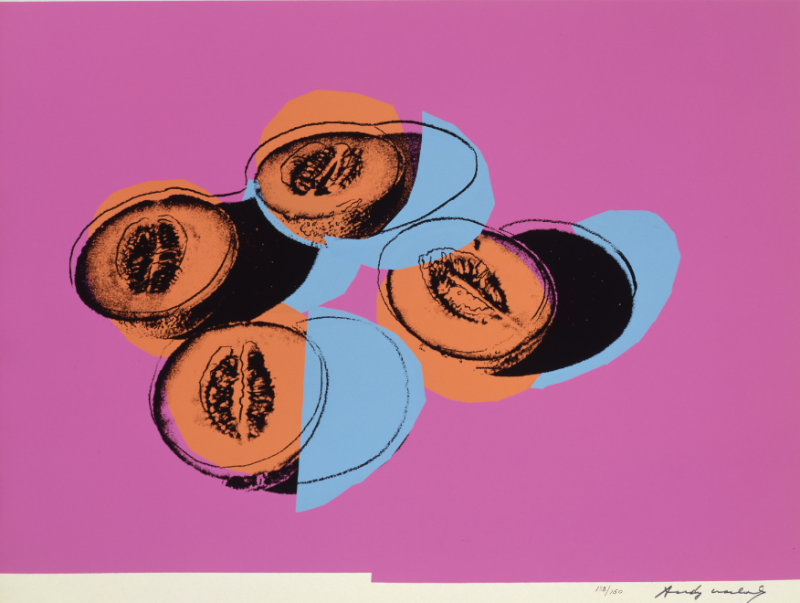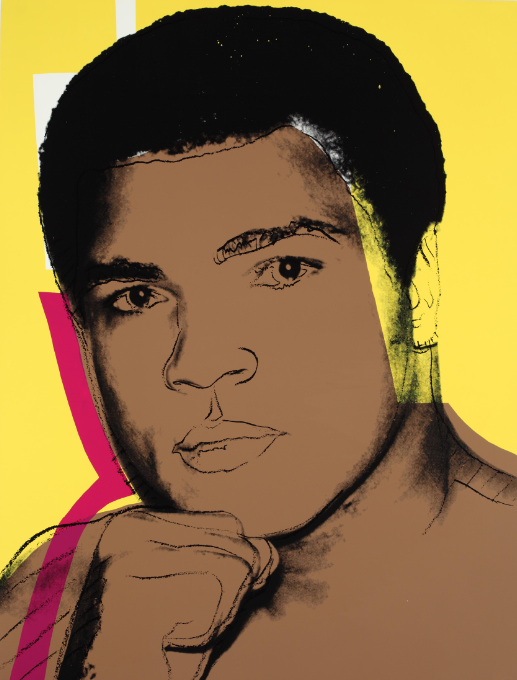Andy Warhol: The Portfolios, Dulwich Picture Gallery | reviews, news & interviews
Andy Warhol: The Portfolios, Dulwich Picture Gallery
Andy Warhol: The Portfolios, Dulwich Picture Gallery
An exhibition of still lifes which are anything but still

The first room of Andy Warhol: The Portfolios at Dulwich Picture Gallery made me regret coming. The second room made me never want to leave. The first has 10 of the Flowers and 10 of the Campbell's Soup Cans, four weedy sunsets and one Marilyn in pink, purple and brown - hardly any nourishment, certainly nothing fresh.
Luckily, there was also Birmingham Race Riot (1964) (pictured below right), which shows what was subtle and original in Warhol's work. A black and white screenprint (apt for a piece on racism), this shows a white policeman with his baton standing by as two ferocious police dogs attack a black man, one dog ripping into his trousers. The image seems to shift between blocky screenprint and mottled watercolour, both monumentalising and fictionalising this encounter, suggesting artistic and literal truths. It is this shifting between reality and fiction which is one of Warhol's greatest successes, and this is proved in the next room.
Space Fruit: Still Lifes (1979), which are on the surface gaudy fruit screenprints, are transfixing explorations of the nature of painting and reality which reassert quite what a genius of the image Warhol was. I sat in front of them taking in the galaxy of ideas and questions Warhol fixed into them, captured by their beauty, their rigour and their nature which oscillates between reality, illusion and immateriality.
Take Cantaloupes II (main picture). Four cantaloupe halves lie - where? They can't be on a table because they are viewed from different perspectives - they don't seem to sit right. Some of their shadows fall beneath other colour planes, some above. The cantaloupes are luminously orange, except their orange ovals seep beyond their lines. There are intrusive light blue circles and semi-circles, and this all sits on large pink blocks, which don't quite occupy the entire paper.
 All of these things serve to discomfort but also to draw you in. The fruit hover between realistic portrayals, cartoon outlines, present objects, colourful abstracts. Everything bleeds across borders of reality. The colours do not just highlight the transitions between these states but enable them by allowing us to dismantle the image. You can never stop looking because each piece of fruit is in perpetual flux: the life in these melons is anything but still.
All of these things serve to discomfort but also to draw you in. The fruit hover between realistic portrayals, cartoon outlines, present objects, colourful abstracts. Everything bleeds across borders of reality. The colours do not just highlight the transitions between these states but enable them by allowing us to dismantle the image. You can never stop looking because each piece of fruit is in perpetual flux: the life in these melons is anything but still.
The best thing is that there are six different pictures in this series here, each with its own challenge to the nature of the image, each a challenge to still lifes of the past and a tribute and answer to Cezanne with his apples. You could spend hours caught in their shifting, puzzling beauty.
The third room returns to celebrity subject-matter, but after Space Fruit their whirling possibilities become all the more entrancing. Muhammad Ali (1978) (pictured above left) reanimates Cubism with a Pop shot in the arm, using four different angles on Ali in one series, as opposed to the multiples of one picture as with the Marilyns. Again, Warhol's use of colour both fictionalises and reifies Ali, which means his portraits of the famous don't become adorations. Are these people real? The portraits don't help us.
Muhammad Ali hangs alongside Ten Portraits of Jews of the Twentieth Century (1980), where Warhol took his distortive use of blocks of colour even further. Frank Kafka is mostly pale blue, but a tiny radius of yellow begins and is quickly extinguished, while a deeper blue triangle points at his left eye. A rogue blue block sneaks in from the bottom. He is abstracted and terrified, mysterious and modern. A blue rectangle is slapped onto Louis Brandeis' forehead and the whole picture feels like it's coming dangerously close to abstraction. Einstein is mainly drawn lines, rather than a photo.
Warhol has gone back to what he knows best: kitsch
Given the subject matter - modern Jews - this technique feels fitting: the shocking colours and glaring blocks are a hysterical response to hysterical, dangerous times; the use of photos and lines permits a shifting between mythology and reality; and there is that comedy-tragedy vital to traditional Jewish humour.
The final room is crowded like Morozov's drawing room, twenty pictures hanging from three walls. Drawn from the Myths (1981) and Endangered Species (1983) series, it feels like we have regressed somewhat. The daring years 1979-1981 have ended up where they started, with rather ordinary Warhols, if there can be such a thing: pop culture icons in bright colours. The spirit of exploration seen in the previous two rooms has subsided and Warhol has gone back to what he knows best, kitsch.
If the flanks of Andy Warhol: The Portfolios disappoint, the central rooms thrill, more than thrill - entrance, excite and enliven. If you want fresh evidence of Warhol's genius, it's only three stops from Victoria Station.
GREAT POP ART RETROSPECTIVES
Allen Jones, Royal Academy. A brilliant painter derailed by an unfortunate obsession
 Ed Ruscha: Fifty Years of Painting, Hayward Gallery. First British retrospective for a modern master
Ed Ruscha: Fifty Years of Painting, Hayward Gallery. First British retrospective for a modern master
Lichtenstein: A Retrospective, Tate Modern. The heartbeat of Pop Art is given the art-historical credit as he deserves (pictured above, Lichtenstein's Masterpiece, 1962)
Patrick Caulfield, Tate Britain. A late 20th-century great emerges into the light
Pauline Boty: Pop Artist and Woman, Pallant House Gallery. The paintings are wonderful, but the curator does a huge disservice to this forgotten artist
Richard Hamilton, Tate Modern /ICA. At last, the British 'father of Pop art' gets the retrospective he deserves
rating
Explore topics
Share this article
The future of Arts Journalism
You can stop theartsdesk.com closing!
We urgently need financing to survive. Our fundraising drive has thus far raised £33,000 but we need to reach £100,000 or we will be forced to close. Please contribute here: https://gofund.me/c3f6033d
And if you can forward this information to anyone who might assist, we’d be grateful.

Subscribe to theartsdesk.com
Thank you for continuing to read our work on theartsdesk.com. For unlimited access to every article in its entirety, including our archive of more than 15,000 pieces, we're asking for £5 per month or £40 per year. We feel it's a very good deal, and hope you do too.
To take a subscription now simply click here.
And if you're looking for that extra gift for a friend or family member, why not treat them to a theartsdesk.com gift subscription?
more Visual arts
 Help to give theartsdesk a future!
Support our GoFundMe appeal
Help to give theartsdesk a future!
Support our GoFundMe appeal
 Ed Atkins, Tate Britain review - hiding behind computer generated doppelgängers
Emotions too raw to explore
Ed Atkins, Tate Britain review - hiding behind computer generated doppelgängers
Emotions too raw to explore
 Echoes: Stone Circles, Community and Heritage, Stonehenge Visitor Centre review - young photographers explore ancient resonances
The ancient monument opens its first exhibition of new photography
Echoes: Stone Circles, Community and Heritage, Stonehenge Visitor Centre review - young photographers explore ancient resonances
The ancient monument opens its first exhibition of new photography
 Hylozoic/Desires: Salt Cosmologies, Somerset House and The Hedge of Halomancy, Tate Britain review - the power of white powder
A strong message diluted by space and time
Hylozoic/Desires: Salt Cosmologies, Somerset House and The Hedge of Halomancy, Tate Britain review - the power of white powder
A strong message diluted by space and time
 Mickalene Thomas, All About Love, Hayward Gallery review - all that glitters
The shock of the glue: rhinestones to the ready
Mickalene Thomas, All About Love, Hayward Gallery review - all that glitters
The shock of the glue: rhinestones to the ready
 Interview: Polar photographer Sebastian Copeland talks about the dramatic changes in the Arctic
An ominous shift has come with dark patches appearing on the Greenland ice sheet
Interview: Polar photographer Sebastian Copeland talks about the dramatic changes in the Arctic
An ominous shift has come with dark patches appearing on the Greenland ice sheet
 Donald Rodney: Visceral Canker, Whitechapel Gallery review - absence made powerfully present
Illness as a drive to creativity
Donald Rodney: Visceral Canker, Whitechapel Gallery review - absence made powerfully present
Illness as a drive to creativity
 Noah Davis, Barbican review - the ordinary made strangely compelling
A voice from the margins
Noah Davis, Barbican review - the ordinary made strangely compelling
A voice from the margins
 Best of 2024: Visual Arts
A great year for women artists
Best of 2024: Visual Arts
A great year for women artists
 Electric Dreams: Art and Technology Before the Internet, Tate Modern review - an exhaustive and exhausting show
Flashing lights, beeps and buzzes are diverting, but quickly pall
Electric Dreams: Art and Technology Before the Internet, Tate Modern review - an exhaustive and exhausting show
Flashing lights, beeps and buzzes are diverting, but quickly pall
 ARK: United States V by Laurie Anderson, Aviva Studios, Manchester review - a vessel for the thoughts and imaginings of a lifetime
Despite anticipating disaster, this mesmerising voyage is full of hope
ARK: United States V by Laurie Anderson, Aviva Studios, Manchester review - a vessel for the thoughts and imaginings of a lifetime
Despite anticipating disaster, this mesmerising voyage is full of hope

Add comment